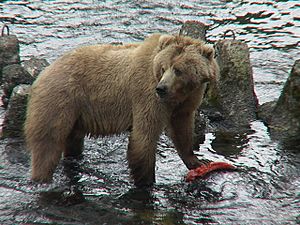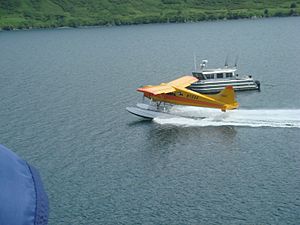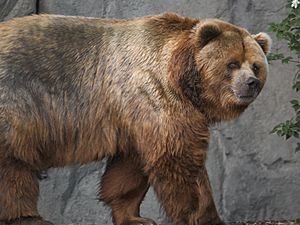Kodiak bear facts for kids
Quick facts for kids Kodiak bear |
|
|---|---|
 |
|
| A bear in Kodiak Island, Alaska, US | |
| Scientific classification |
|
| Kingdom: | Animalia |
| Phylum: | Chordata |
| Class: | Mammalia |
| Order: | Carnivora |
| Family: | Ursidae |
| Genus: | Ursus |
| Species: | |
| Subspecies: |
U. a. middendorffi / horribilis
|
| Trinomial name | |
| Ursus arctos middendorffi / horribilis Merriam, 1896
|
|
The Kodiak bear (Ursus arctos middendorffi) is also called the Kodiak brown bear. It lives on the islands of the Kodiak Archipelago in southwest Alaska. This amazing animal is the biggest type of brown bear. It is also one of the two largest bears alive today, along with the polar bear.
Kodiak bears are very similar to other brown bears, like the grizzly bear on the mainland. The biggest difference is their size! Most brown bears weigh between 115 and 360 kilograms (254 and 794 pounds). But Kodiak bears often weigh from 300 to 600 kg (660 to 1,320 lb). Some have even weighed over 680 kg (1,500 lb). Even though they are huge, their diet and daily life are much like other brown bears.
People and Kodiak bears have not met often in the past. But today, these meetings are more common. This is because more people are living in the area. People have hunted bears for their fur or meat. Sometimes, bears have attacked people, but this is rare. Lately, people are working harder to protect these bears. They want to make sure the Kodiak bear population stays healthy.
The IUCN says that brown bears, including Kodiak bears, are not in danger of extinction. However, the IUCN does not look at different types of brown bears separately. So, we do not know for sure how healthy the Kodiak bear population is. Because of this, the Alaska Department of Fish and Game watches how many bears are hunted in Alaska very closely.
Contents
About Kodiak Bears
What is a Kodiak Bear?
A scientist named C.H. Merriam was the first to say that the Kodiak bear was a special type of brown bear. He named it "Ursus middendorffi" to honor a famous scientist, Dr. A. Th. von Middendorff. Later, all North American brown bears were grouped into one species, Ursus arctos.
Scientists have studied the genes of Kodiak bears. They found that these bears are related to brown bears on the Alaska Peninsula and in Kamchatka, Russia. Kodiak bears have lived separately for a very long time, since the last ice age (about 10,000 to 12,000 years ago). This means they do not have much variety in their genes. Even though the bears are healthy now, they might be more likely to get new diseases or parasites. This is because they have less genetic variety than other brown bear groups.
What Color Are They?
Kodiak bears can have many different hair colors. Some are blonde or orange, especially females or bears from the southern islands. Others are dark brown. Young cubs often have a white ring around their neck for their first few years. Their color is similar to other brown bears in America and Europe.
How Big Are They?
Female Kodiak bears, called sows, usually weigh from 181 to 318 kg (400 to 700 lb). Male Kodiak bears, called boars, weigh from 272 to 635 kg (600 to 1,400 lb). Adult males usually weigh between 477 and 534 kg (1,052 and 1,177 lb) during the year. They can weigh up to 680 kg (1,500 lb) when they are fattest. Females are about 20% smaller and 30% lighter than males. Bears reach their full size when they are about 6 years old.
Bears are lightest when they come out of their dens in the spring. They can gain 20–30% of their weight in late summer and fall. Bears living in zoos can sometimes grow even bigger than wild bears.
An average adult male Kodiak bear is about 244 cm (8 ft) long. It stands about 133 cm (4 ft 4 in) tall at the shoulder. The biggest wild male ever recorded weighed 751 kg (1,656 lb). A large male Kodiak bear can stand up to 1.5 meters (5 ft) tall on all four legs. When standing fully on its hind legs, a large male can reach a height of 3 meters (10 ft)!
The largest Kodiak bear in a zoo was named "Clyde." He lived at the Dakota Zoo in Bismarck, North Dakota. When he died in 1987, he weighed 966 kg (2,130 lb). He probably weighed even more a year before that. Kodiak bears are the largest brown bears, similar in size to polar bears. This makes them the two biggest meat-eating animals on land.
Scientists often measure a bear's skull to figure out its size. The largest bear skull ever found in North America was from Kodiak Island. Many of the biggest brown bear skulls recorded are from Kodiak.
Where Do They Live?
Kodiak bears only live on the islands of the Kodiak Archipelago. These islands include Kodiak, Afognak, Shuyak, Raspberry, Uganik, Sitkalidak, and nearby islands. In 2005, there were about 3,526 Kodiak bears. This means there were about 270 bears for every 1,000 square kilometers (700 per 1,000 sq.mi). The number of bears has been slowly growing over the last ten years.
Life Cycle of Kodiak Bears
Reproduction and Survival
Kodiak bears can start having cubs when they are about five years old. But most females, called sows, are over nine years old when they successfully raise their first litter. They usually have cubs every four years. Sows keep having cubs throughout their lives, but they have fewer after they turn 20.
Mating season for Kodiak bears is in May and June. A male and female bear will stay together for two days to two weeks. After the egg is fertilized, it stops growing for a while. It does not start growing again until autumn, when it attaches to the mother's womb. Cubs are born in the den during January or February. They weigh less than 450 grams (1 lb) at birth. They have little hair and their eyes are closed. They drink milk for several months. They come out of the den in May or June, weighing about 7 to 9 kg (15 to 20 lb).
Most Kodiak bear litters have two or three cubs. But some sows have been seen with five or six cubs! This might happen if they adopt cubs from other litters. Most cubs stay with their mothers for three years. Sadly, almost half of the cubs die before they leave their mothers. Adult male bears sometimes kill cubs, which is a major cause of death.
Young Kodiak bears, aged 3–5 years, have a high chance of dying. Only 56% of males and 89% of females survive after leaving their mothers. Most young female bears stay close to their mother's home area. But most young males move farther away. Most adult female bears die from natural causes. However, most adult male bears are killed by hunters. The oldest known wild Kodiak bear was 27 years old. The oldest female was 35.
Denning Habits
Kodiak bears start going into their dens in late October. Pregnant females are usually the first to go into dens. Males are the last. Males start coming out of their dens in early April. But females with new cubs might stay in their dens until late June. Bears living on the north side of Kodiak Island stay in their dens longer than bears in the south.
Most Kodiak bears dig their dens into hillsides or mountainsides. They use many different types of places for dens, depending on where they live. Almost a quarter of adult bears do not den at all. They stay somewhat active throughout the winter.
Home Range
Kodiak bears are usually active during the day. But if there is a lot of competition for food or space, they become more active at night. This is often seen in bears living near Kodiak City.
Kodiak bears do not defend their areas like territories. But they do have traditional areas they use every year, called home ranges. Because there is so much food on Kodiak, these bears have some of the smallest home ranges of any brown bear in North America. Many bears' home ranges overlap. Adult female bears on Kodiak Island have home ranges that average about 50 square miles (130 km2). Male bears have home ranges that average about 97 square miles (250 km2).
Habitat and What They Eat

The Kodiak Archipelago has a cool, wet climate. It often has cloudy skies, fog, wind, and rain or snow most of the year. The islands cover about 13,000 square kilometers (5,000 sq mi). They have many different types of land and plants. There are thick forests of Sitka spruce trees on the northern islands. There are also steep, icy mountains, and rolling hills with flat tundra in the south. About 14,000 people live on the islands, mostly near Kodiak City.
Bears live all over the islands. They adapt to the food available in their area. In the spring, bears eat new plants and animals that died during the winter. As summer goes on, they eat many different plants. Then, salmon return to the streams. Salmon runs happen from May to September. Bears eat all five types of Pacific salmon that lay eggs in the local streams and lakes. In late summer and early fall, bears eat many kinds of berries. They also eat seaweed and small sea creatures on some beaches all year.
Even though deer and mountain goats live on the islands, Kodiak bears do not often hunt them. Another food source is garbage from human towns. Climate change is causing elderberries to ripen earlier. This means berry season now happens at the same time as salmon season. Some bears are choosing to eat berries instead of salmon.
Kodiak Bear Behavior
Kodiak bears are smart, like other brown bears. They often gather in large groups to eat. This leads to more complex ways of behaving with each other. Kodiak bears are usually solitary, meaning they live alone. But when food is plentiful in a small area, like a salmon stream, berry patch, or even a garbage dump, many bears will gather. In some streams on Kodiak, you can see up to 60 bears at once in a small area. To get enough food in these important places, bears have learned to avoid fighting. They use special sounds and body language to communicate and get along.
Interactions with People
Usually, Kodiak bears try to stay away from people. But sometimes, they might react if they are surprised, feel threatened, or are attracted to human food, garbage, or game killed by hunters. Lately, there have been more meetings between bears and people. This is because more people live on the islands and more bears are being hunted.
To stay safe, it is important to avoid surprising bears. It is also good to understand what bears need and how they behave. Learning to recognize a bear's warning signs when it is stressed can help prevent problems.
History and Management
Early History
Long ago, the first people on the islands, the Alutiiqs, hunted bears. They used the meat for food, the hides for clothes, and the teeth for decorations. Their stories often talked about how similar bears and humans were. They also believed bears had a special connection to the spirit world.
Protecting the Bears
In the early 1900s, people became worried about too many bears being hunted. Hunters and scientists realized the Kodiak bear was the biggest in the world. They wanted to protect them. In 1925, the government stopped commercial bear hunting (selling hides) on the islands. This helped the bear population grow.
By the 1930s, ranchers on Kodiak said bears were causing problems. Bears were also seen as a threat to the growing salmon fishing industry. To help both bears and people, President Franklin D. Roosevelt created the Kodiak National Wildlife Refuge in 1941. This large refuge covers most of Kodiak Island and some other islands.
When Alaska became a state in 1959, it took over managing the wildlife. The state made rules for bear hunting. Over the years, people worked to find ways for bears and people to live together.
Changes to Land and Research
In the 1970s and 1980s, some land on the islands changed ownership. Also, a big hydroelectric project was built on Kodiak Island. These changes meant more human activity in bear habitats. This led to more interest and money for bear research on Kodiak. Scientists learned a lot about the bears during this time.
The Exxon Valdez oil spill in 1989 did not directly harm Kodiak bears. But some bears had to move away from their usual feeding areas because of cleanup crews. No one was hurt by a bear, and no Kodiak bears were killed. Money from the oil spill settlement was used to buy land. This helped protect important bear habitats on the islands.
Kodiak Archipelago Bear Conservation and Management Plan
In 2001, a group of citizens worked with the Alaska Department of Fish and Game to create a plan for managing Kodiak bears. This plan looked at hunting, habitat, and bear viewing. The group, made of people with different ideas, came up with over 270 ideas to manage and protect Kodiak bears. Everyone agreed on these ideas.
The main goals of the plan were to keep the bear population healthy, teach people how to live safely with bears, and protect bear habitats while still allowing people to use the islands. The government agencies promised to follow as many of these ideas as possible.
Are Kodiak Bears Endangered?
The IUCN does not list different types of brown bears separately. The brown bear species, which includes the Kodiak bear, is listed as "Least Concern." This means they are not in danger. The Kodiak bear is not listed as an endangered species by the U.S. Fish and Wildlife Service.
Hunting Management
The Alaska Department of Fish and Game (ADF&G) manages bear hunting on Kodiak. Each year, about 4,500 people apply for 496 permits to hunt Kodiak bears. Hunters must follow strict rules. Every bear killed must be checked by an ADF&G biologist before it can leave the islands. Hunting laws are strongly enforced. People in the community respect the island's environmental laws. Illegal hunting has serious penalties.
From 2000 to 2006, about 173 Kodiak bears were killed by hunters each year. Most of these were males. A few more bears were killed each year to protect people or property. The number of very large, trophy-sized bears killed by hunters has been going up.
Bear Viewing

In the last 20 years, watching bears has become very popular on Kodiak. More and more people visit places like Frazer River to see bears. While bear viewing does not involve hunting, it can still affect bears if not done carefully. Most viewing happens where bears gather to eat important foods. If bears avoid these areas because people are there, they might not get enough food for winter.
Some people feel that bear viewing and bear hunting do not mix well. They think it is not fair to encourage bears to be close to people in the summer, only to allow them to be hunted in the fall. The Kodiak bear plan says that bear hunting is a fair and traditional activity. It suggests that agencies find ways for bear hunting and bear viewing to happen together on the islands.
Cultural Significance
The bear is very important to the Alutiiq people. Its name in the Alutiiq language is Taquka’aq. The pronunciation changes a bit depending on where people live.
See also
 In Spanish: Oso Kodiak para niños
In Spanish: Oso Kodiak para niños


